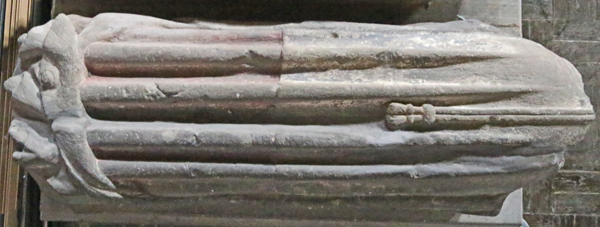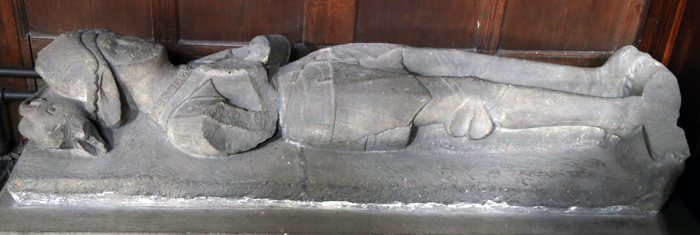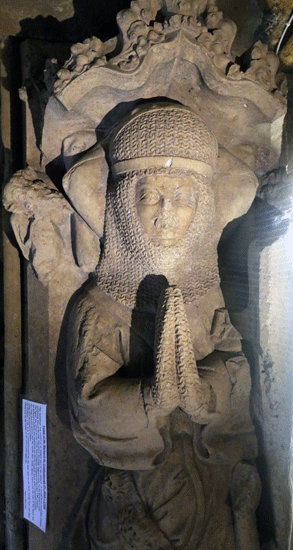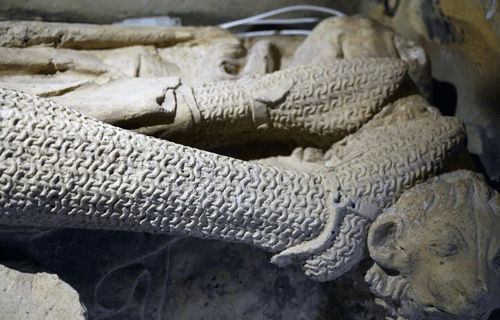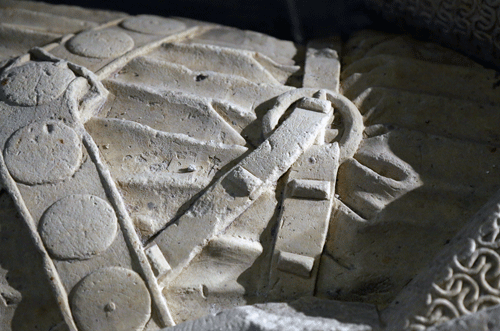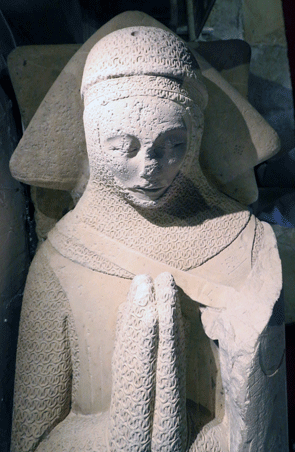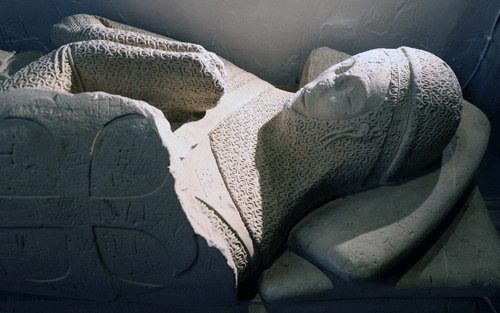|
 |
Right:
Monument of Willia[m]
Aldborough (1627) and his wife, Anne (Kay)
(1615)
I cannot accurately make out the modern information here.
Also (but not shown): Brass of William de Aldburgh
(c. 1360) |
|
|
Allerton Mauleverer -
St Martin |
Church open
The medieval effigies are in a locked chapel on the floor; as an
extra precaution - and a wise one - the wooden ones are clamped
down as well |
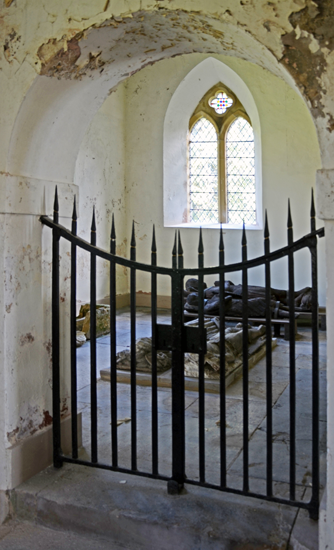
Above: The effigies in the chapel
Right top: Alabaster effigies of Sir John
Mauleverer (1468) & Catharine (?)
Right bottom: Two oak effigiesearly 14th
century
Below: The effigies and a sone coffin |
 |
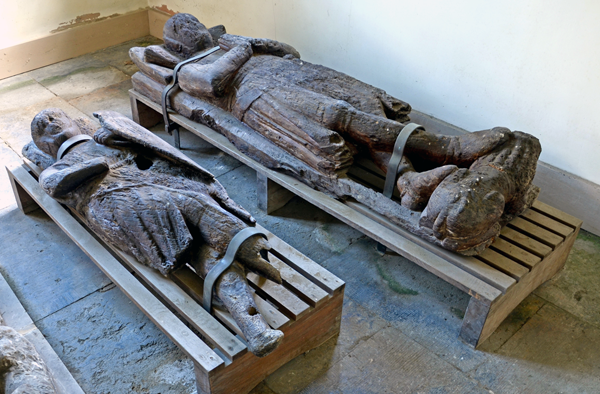 |
|
 |
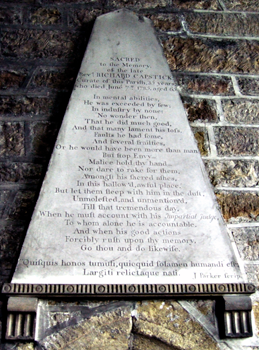 |
I cannot quite make this out: the
text begins with Hic Iacet and the name is
probably below. There are two long quotations: one from
Corinthians and the other from Philippians. The date at
the bottom is 1684 |
Rev Richard Capstick
(1785)
35 years curate
Sig: J Parker ſerip |
|
 |
Knight holding heart of early 14th
century; oak and very fine. The canopy belongs to the tomb of
Percival Cresacre (1477) Inscriptions |
|
|
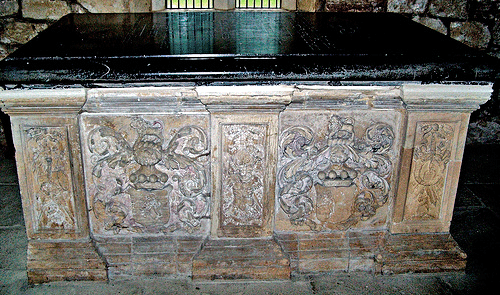 |
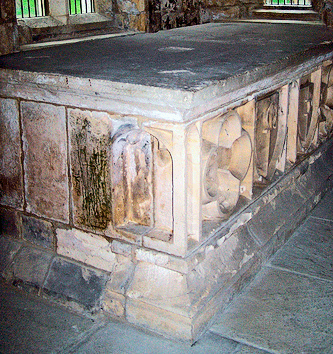 |
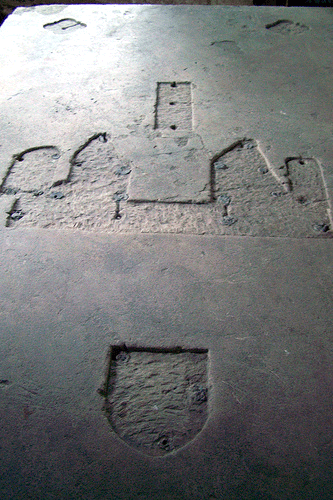 |
Left: Thomas,
3rd Lord Fairfax (1671), usually referred to as Sir
Thomas Fairfax or 'Black Tom', and his wife Anne.
Thomas Fairfax was Lord General of the New Model Army,
which was responsible for the defeat of Charles I, having
learned his soldiering skills in the Thirty Years' War. Although
he was appointed as one of the commissioners to try the King, he
did not attend and, although the General , he made no attempt to
stop either the trial of the execution of the King. Oliver
Cromwell was the Lieutenant General at this time; he later
became Lord General when Fairfax, being reluctant in invade
Scotland in the Third Civil War, resigned his commission.
Centre and right:
John Norton He was founder of this
church in the 15th century. The photographs show his tomb
chest and the lid with indents of lost brasses.
|
|
 |
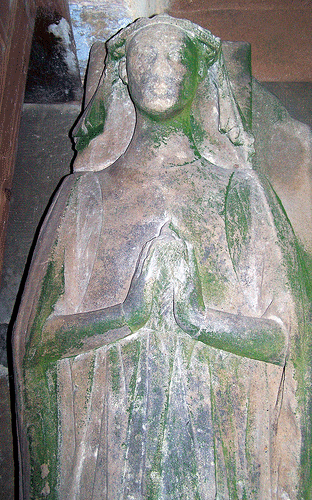 |
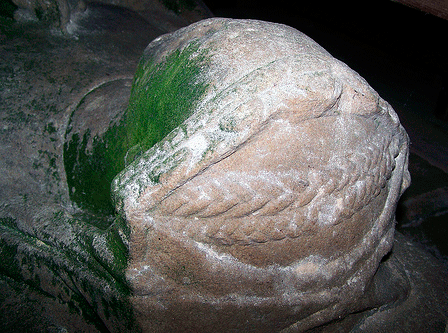 |
| Lady of the early 14th century in the south chapel. The
left hand photograph above shows her braided hair. |
|
 |
 |
 |
| Thomas Leach (1763) 'of the
honourable Societies of Greys Inn & Staple Inn...' |
David _ 17_
Also his daughter Agnes (1714) |
General
William Twiss (1827)
Royal Engineers. He was responsible for a number of
defenses both in Britain and overseas, including those at
Portsmouth Dockyard and the series of Martello Towers; one of
these can be see on the monument with cannon. A road is named
after him in Hythe, Kent, his birthplace |
| I presume the monument to
General Twiss is the one Pevsner refers to (The Buildings of
England: Yorkshire, West Riding) when he writes, one by
J. Gott c. 1835. He also refers to a monument to Mrs
Caroline Benfield by Behenes 1848, but I do not have a
photograph |
|
 |
 |
Cross and Sword
grave cover |
Anthony Littledale (182_)
Buried in the same vault as his (unnamed) mother at Haldock,
Hertfordshire. And his wife, Mary (Dawson) (Littledale)
(1855), who is buried in the chancel. |
 |
 |
Very large gray marble slab to Sir
Ralph Pudsey (1481), his three wives and twenty five
children. The parents are represented on the top row and
are said to represent (although they do not appear to be named
on the slab): 1. Second wife, Margaret (Tunstall)
who had six children; First wife, Matilda (Tempest)
who had two children, and: Third wife, Edwina
__ who had seventeen children. The children appear to
be each named above their representation but I cannot make this
out from the photograph. |
|
Samuel
Hailstone (1833) (Arabic), Samuel Hailstone
(1841) (Roman), Samuel Hailstone (1851)
(Roman). White tablet with leaves atop on black gabled
base. By Skelton, York
Julia Lyddon (Silly) (1828) White tablet with
urn. By Wilson, Leeds |
|
|
Bradford Cathedral |
| The Cathedral Church of St Peter is a
Cathedral of the Modern Foundation, the see being founded in
1918. At the Reformation it was a parish church, the oldest
parts dating back to the 15th Century |
 |
 |
 |
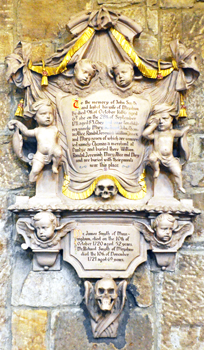 |
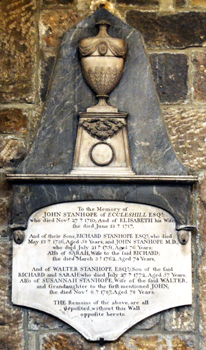 |
 |
 |
Above from left to right:
1) Thomas Clapham (1719).
Latin Text 2) Isaac Hollings (1735)
3) John Rand (17--) and his
wife Elizabeth (18--) 4) John (1686) &
Isabel Smyth (1711) Their
children William, Randal, Jeremiah, Mary, Alice
& Mary
'...buried with their parents near this place..'
Thomas buried at Dantzic (area of Manchester). John
referred to earlier is missing. Below is
added: James (1720) & Richard (1721).
5) John Stanhope (1710), his
wife, Elizabeth. Their sons: Richard
(1736) & John MD (1751). Also
Richard's wife, Sarah (1762) and their son,
Walter (1775), and his wife, Susannah,
who was granddaughter of the first mentioned John. 'THE
Remains of the above, are all depoſited,
without the Wall oppoſite hereto' 6) IN THIS VAULT at the
Foot of this Pillar Rest the Remains of: Nancy (1806),
wife of James Stead; Frances Mawson
(1817), their daughter;
Robert Mawson (1824), husband of
Frances; Frances (1824) Aged 8 and daughter
of Robert and Frances aforementioned; James Stead (1825)
also aforementioned; Elizabeth Stead (1828)
Aged 7 and daughter of John and Phoebe [they have not been
mentioned heretofore] ; James Mawson (1829), son of
Robert and Frances. Also, Thomas Ogden (1835),
aged 18 and the eldest son of Joshua and Mary Stead [they have
not been mentioned heretofore] and grandson of James;
Phoebe Stead (1844) Aged 15 and daughter of
the aforementioned John and
Phoebe; Samuel (1846) Aged 15 and youngest son
of the aforementioned Joshua and Mary. 7) Marie Lister (1809)
Latin text |
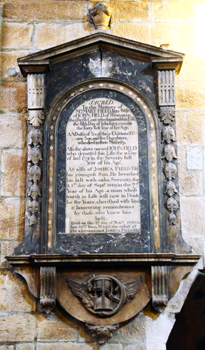 |
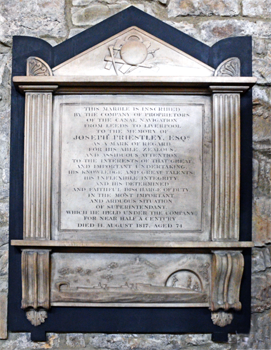 |
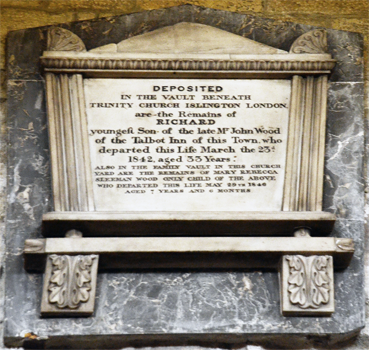 |
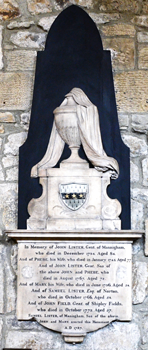 |
| Mary Field (1750) and her
husband, John Field (1772). And six of their
children who died in their Minority. Also the youngest son,
Joshua (1819). Added below, Mary (1830),
widow of Joshua. |
Joseph Priestley (1817)
He superintended the building the Leeds and Liverpool
Canal. Note the low relief of a canal at the base and the
navigators' tools at the top.
By William Pistell |
'Deposited in the vault beneath Trinity
Church, Islington, London...' Richard Wood (1842).
'Also in the family vault in this church are the
remains of Mary Sleeman Wood (1840) ...only
child of the above. Aged 7 1/2 |
John Lister (1734), his
wife, Phebe (1745) ; their son, John
(1767); his wife, Mary (1756);
Samuel Lister (1766); John Field (1772) |
| Other
Monuments |
Rev
William Scoresby DD FRS FRSE (1789-1857)
Yorkshire man, Arctic Explorer, Scientist. Vicar of Bradford
(1839-1847) Died at Torquay, Devon where he is buried. Blue
enamel tablet.
Anne Sharp (1834) Wife of William, surgeon.
Their daughter Annie (1846). White tablet on
black base.
Thomas Mann (1832 ?); his
daughter, Eliza (1810 ?) Aged
15; his son, Thomas (1841); his wife,
Betty (1843). And two infant children, Joseph
and Elizabeth. White tablet with
pediment and apron both with leaf patterns, on black base.
Pte Eric Anderson VC. East Yorkshire Regiment.
Awarded for rescuing three wounded comrades at Wadi Akarit 6th
April 1943 whilst under enemy fire. Gray tablet with yellow
lettering
In a vault within the tower of this church lie interred the
bodies of three infant children of Samuel Hailstone and Ann, his
wife...viz: Thomas (1816) aged 2;
William (1816) aged 1; Frances (1824)
aged 4. White tablet with cornice and black base.
John Hardy (1806); his fist wife, Annis
(1774), buried at Horsforth; his second wife,
Mary (1804), ' ... buried beneath the font in this
church'. White tablet with apron and cornice on black base.
The following three monuments are in the north aisle but I do
not have a photograph:
Abraham
Sharp (1742) Table with mathematics instruments. A
Bradford born mathematician and astronomer who calculated
π to 72 decimal places, briefly holding
the record. A moon crater is named after him. By
Sheemakers.
Faith Sawney (1761) Sarcophagus with two
putti in an aedicule. By J F Moore
Abraham Balme (1796) A
Bradford Worsted manufacturer. By
Flaxman. A relief of a man with a beard reading to two young
people
William Sharp (1833) A famous surgeon at
St Barthomew's Hospital. Free standing bare breasted Grecian
maiden holding a portrait medallion by Joseph Gott. (Pevsner)
South transept but no photograph available
†
† The only reference to a William
Sharp associated with Barts is
here. This William Sharp was anyway only associated with
Barts for four years, died in 1810 and was buried at All Saints,
Fulham, where his tomb may be seen. His short biography makes
interesting reading. There is however another surgeon -
also William Sharp - who died at Bradford in 1833 and was buried
at Gildersome Church. His monument is in the Cathedral and was paid for
by public subscription; however it is a profile bust in low
relief with a tablet below giving information. This monument is
by Joseph Gott and there is a photograph on the internet. I
have not been able to find any reference to the monument
described by Pevsner. |
|
 |
 |
 |
 |
| Far left: 'To the
memory of those through accidents in constructing the rail works
between Settle and Dent Head.' They are not named. This recalls
part of the Victorian engineering triumph of the Settle-Carlisle
Railway, which is referred to above centre left on a plaque
on the stone in the church yard in the millennium year of 2000:
'To the memory of the many men, women and children resident in
this parish between 1870 and 1877 who died through accident or
disease during the construction of the
Settle to Carlisle Railway and who are buried in this church
year. Centre right:
Abraham _dale (1781) Far
right: Mary Walton (1819) |
|
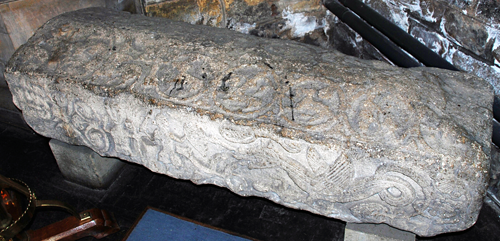 |
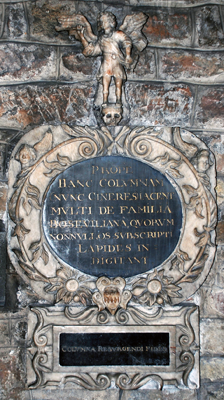 |
 |
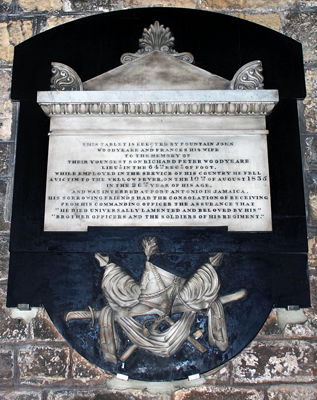 |
Above: 12th
century tomb chest. Much wonderful, intricate carving on all
aspects.
Right near: The Latin inscription says that many of the
Boseville family are buried near this pillar.
Right centre: Fountain John (Elwin) Woodyear
(1841), and his widow, Frances Woodyeare (1844).
[He] 'assumed the name and arms of Woodyeare by Royal Sign
Manuel in 112'
Right far: Richard Peter Woodyeare (1835)
Son of above. Lt 64th Reg of Foot. Died of yellow fever and was
buried in Port Antonia, Jamaca.
|
| Other
Monuments |
| Ann Tileman
(1832) and her grandson, Stainforth Cattley
(1835) 'Scholar of Queens College, Oxford' Age 20 |
|
 |
 |
 |
| Elizabeth Harvey (1799) |
Midshipman John Slingsby
(1915)
KIA on HMS Formidable; and his friend:
Geoffrey Ernest Cable (1915) |
Edward Bertram Fawcett
(1916)
Cpt 92nd Punjabis
KIA Sunni-i-Yat, Mesopatamia |
| Other
Monuments |
Rev John Hallewell BD
(1818) 36 years minister of this parish and
above 30 years vicar of Nid. Also his wife Ellen
(1842), who dies and was buried at Stroud,
Gloucestershire. White tablet with gable and apron.
|
|
|
Fountains
Abbey |
Fountains is one of the largest and best
preserved Cistercian houses in Britain.
It is under the care of the National Trust. Entry fees: £16 for
adult (plus concessions). Free for members of NT and English
Heritage |
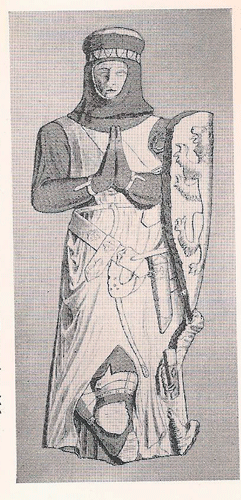 |
| Knight early 14 century |
|
|
 |
Giggleswick - St Alkelda |
 |
Church is open during
normal hours but parking in the village can be difficult; there
may be parking spaces on the road that runs above the village -
the B6480.
Very friendly church.
Good toilets inside the church.
The dedication (there is only one other - at Middleham, NR) is
said to come from the name of a local Anglo Saxon woman who was
martyred in the 9th or 10th century by the pagan Danes, or from
holy well (Haeligheld in Old English).
The
village name is from -wic meaning village and a
Scandanvian chief called Ghigel.
O/S Ref: SD 812 641 |
 |
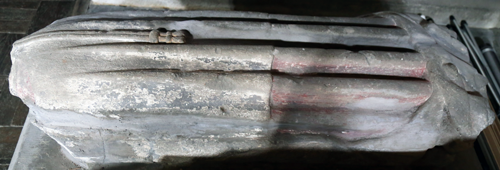 |
| Knight, said to be Sir
Richard Tempest (1488); he was knighten at the Battle
of Wakefield in 1460, accused of treason the following year,
but pardoned by King Edward IV the following year. The two
ladies, although in very
poor condirion, do show remains of polychrome. They are said to
be of the two wives of Sir Richard: Sibill (c 1460)
and Mabel (1511) These two effigies
were found buried at the north east end of the church. |
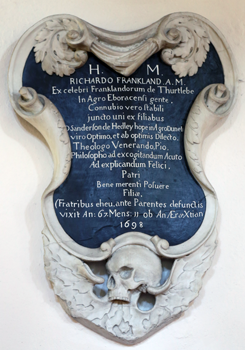 |
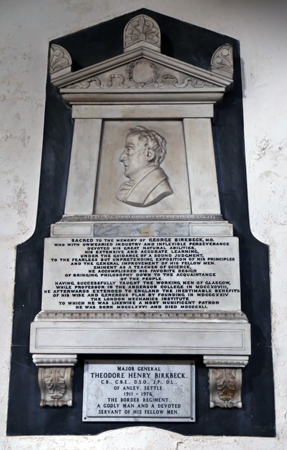 |
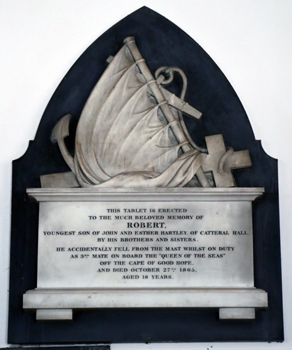 |
Above: Richard
Frankland AM (1698) Latin inscription
Right:
George
Birkbeck MD (1841). Physician, academic,
philanthropist and pioneer in adult education. In 1823 he
founded the London Mechanics Institute, which became Birkbeck
College. He was buried in Kensall Green Cemetery. Below is a
small tablet to Mjr Gen Theodore Henry Birkbeck CB CBE
DSO DL The Border Regiment |
Robert Hartley (1865)
He accidentally fell from the mast while on duty as third mate
on board Queen of the Seas of the Cape of Good Hope. He
was 18 |
| Other Monuments |
Henry Woods
(1817) and his wife Isabella (1826).
Gray tablet with gold incised lettering.
Mary Beckwith (1820) while tablet black base. |
John (1840)
and Mary Hartley (1811) ans their son
John (1840) White tablet on black base with
gable with arms in the latter.
2nd Lt John Starkie Preston (1900) Kia at 21 in
the South African War and his brother Cpt Thomas Hawarth
Preston (1914) Kia at 33 in WWII |
|
 |
Goldsborough -
St Mary the Virgin |
 |
Near Knaresborough. Park in the lane outside
the church. The church is kept lock (it was not in the 1980's)
so you will have to apply to the churchwardens to visit.
However, English Heritage requires that the church be unlocked
during July and August, presumably to fulfill terms of a grant;
this appears not to be appreciated by the church
O/S Ref: SE 385 561 |
The two medieval effigies in the church,
which lie opposite each other in the chancel, are in excellent
condition and very fine, showing interesting and unusual detail.
Note the intricate carving of the mail, instead of the usual
rows of c's and reversed c's.
Above and right :Sir
Richard V de Goldesborough (1333).
Some unusual features:
over the head of the effigy is an agee canopy called a
gablet (a canopy more properly refers to a structure over the
whole monument). Gablets occur from time to time on recumbent
monuments but are more commonly seen over vertical statuary,
where they act as protection from the weather. This
feature over recumbent effigies, as well as other other more
controversial items, has led some - including the late M.P.
Enoch Powell - to conclude that these effigies were designed to
be appear verical.
Over the mail on the top of the head is what is thought
to be a face cloth thrown back and which appears to fall onto
and be stitched to the pillow. This is very rare and on one
moument angels are shown lifting back this cloth. The detail photographs show the
pattern of the sword belt and the prick spurs.
Below:
Sir Richard IV de Goldesborough (1307).
This
effigy lies on a tomb chest. Note the carved heraldry on the
shield. The detail photographs show the lacing of the mail flap
where it passes under the chin and fixes to rest of the mail on
the side of the face; the lacing and fastening of the sword and
waist belts; the buckles fastening the prick spurs.
|
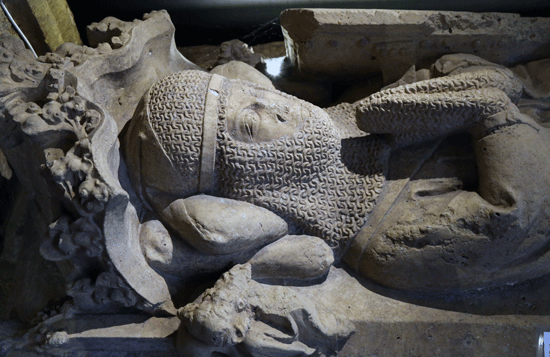 |
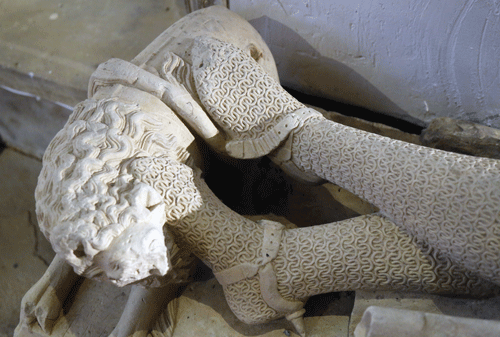 |
 |

|
|
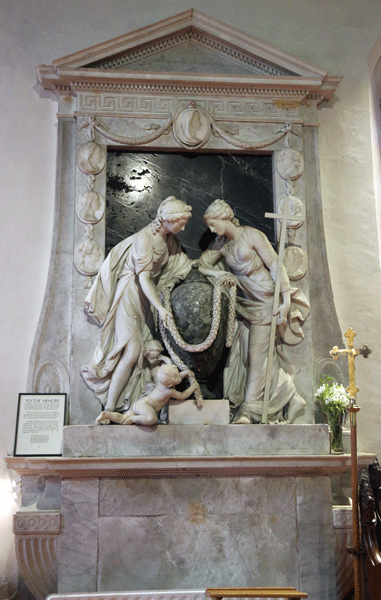
Left top: Small medieval gave
cover, now in the porch.
Above and left bottom: Robert and Mary Byerly by
Joseph Wilton. The figures represent Hope and Charity. 18th
century. |
 |
|
| |
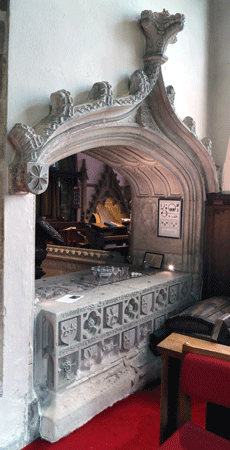 |
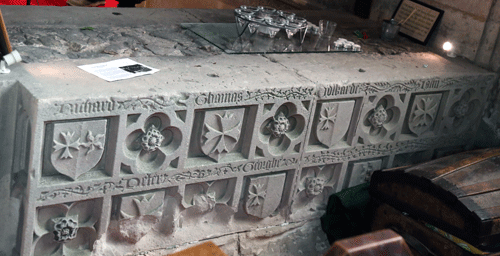 |
 |
Sir Richard de Goldsborough (1504)
Limestone tomb chest said to have originally been in
the Goldsborough chapel. There is no effigy or brass nor any
record of there having been one, although the rough stone work
at the centre of the lid indicates there may well have been
something of this nature. |
|
| |
| |
| The etchings are from Hollis and the drawings from I'Anson; the
photographs from Sally Badham, Jean McCreanor and Richard Collier (thank
you all), except those in Ripon,Wakefield
and Goldsborough which are by the Web Master |
| |
| <Top pf
Page> <Yorkshire
- West Riding 2> <Yorkshire
- West Riding 3> <Yorkshire - West Riding 4> <Home - Gazetteer - Page> |
| |












































